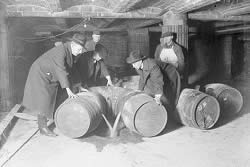In 1917 the American Senate put forward a proposed Eighteenth Amendment to the Constitution to ban the sale and manufacture of alcohol in the United States. This amendment was put forward because of the abuse of alcohol by a percentage of Americans during this post World War One period.
This period of the Eighteenth Amendment to the Constitution banning alcohol is seen as the Noble Experiment, but is officially the Prohibition in the United States.
Today you will find out why the United States brought in prohibition, what happened during the prohibition period and why it stopped.
 Throughout the 18th century and 19th century physicians and temperance movements talked about the illness of drunkenness and a likened it to physically and mental problems. With America being a very religious country the excesses of alcohol were also seen as an excess of the deadly sins too.
Throughout the 18th century and 19th century physicians and temperance movements talked about the illness of drunkenness and a likened it to physically and mental problems. With America being a very religious country the excesses of alcohol were also seen as an excess of the deadly sins too.
The prohibition movement started moving more quickly in 1869 when the Prohibition Party was set up and the Woman’s Christian Temperance Union followed a few years later.
By 1881 Kansas outlawed alcoholic drinks as part of its constitution and by 1890 until the prohibition of the 1920’s the “dry” folk who wished for prohibition advanced their desire for prohibition. It was also during this time that many people starting turning against the saloons, not only from an anti-alcohol point of view but also because of the influence saloons carried in political circles.
In 1917 the 65th Congress was formed and of the 204 members 140 were people who favoured prohibition. It was also during this period a renewed case for prohibition was caused, the only people who countered it seemed to be the German-American immigrants whom many ignored because of the ongoing World War One which America had joined.
Because of this renewed case and the high percentage of pro-prohibition members of Congress the proposed Eighteenth Amendment to the Constitution was put forward to ban alcohol. By the end of 1917 the new amendment was passed 36 states ratified the amendment.
In January 1920 the Eighteenth Amendment to the Constitution came into effect and it was then illegal to sell or manufacture alcohol. The name of the amendment was the National Prohibition Act otherwise known as the Volstead Act
Alcohol consumption did reduce because of the act but there were further reaching consequences.
One of the interesting wording terms in the Volstead Act was that it was not illegal to drink alcohol and people were allowed to make alcohol at home for their own consumption as long as it was made of fruit. This meant many vineyards were started with the view to sell the fruit on to the public to make their own alcohol.
It was also found that many people simply bought massive quantities of alcohol prior to Prohibition and simply stored it at home so they still had a source of alcohol.
The Federal Law enforcement agencies were known not to actively enforce the new Volstead Act when they found persons selling alcohol illegally. This meant a new type of saloon sprang up called a Speakeasy; a term meaning the people within had to talk in a more quiet fashion (speakeasy) so not to draw attention to the premises.

The number of Speakeasy illegal saloons was huge and they sprang up at a rampant pace. In fact it is said that by 1925 there were at least 30,000 to as many as 100,000 of these illegal premises in New York alone.
The problem with these illegal saloons was that many were run by criminal gangs and underground criminals. Furthermore the people who made the illegal alcohol and shipped it for sale were clearly of a criminal nature. This meant the prohibition movement was generating more criminal activity.
The repeal of the prohibition in the 1920’s
The first sign of people trying to repeal the Volstead Act actually came in the form of the medical community as they had many alcohol related medicines and the Act also made alcohol medicines illegal.
Countries neighbouring America such as Mexico and Canada found their alcohol trade flourished as many came into neighbouring countries to purchase alcohol and take it into America; this was deemed to show that it was also affecting the American economy.
By the late 1920’s the trade of illegal alcohol became a source of criminal gangs gaining more and more power. This all came to a head in 1929 when two warring criminal gangs faced one another in Chicago on the 14th February and the resulting in the Saint Valentine’s Day massacre where seven Irish criminal gang members were gunned down.
The criminal and economical issues along with the unrest among the everyday people of the large American cities forced the government to review the prohibition situation. By March 1933 the United States government decided to repeal the National Prohibition Act with President Franklin Roosevelt amending the Volstead Act to include the Cullen-Harrison Act which allowed the sale of alcohol that carried a percentage of up to 3.2%.
By December in 1933 the act was fully repealed and alcohol could be sold once again.

awesome love drinking
[b]hi good lol[/b] 😀 😡 😕